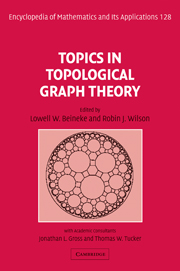Book contents
- Frontmatter
- Contents
- Foreword
- Preface
- Introduction
- 1 Embedding graphs on surfaces
- 2 Maximum genus
- 3 Distribution of embeddings
- 4 Algorithms and obstructions for embeddings
- 5 Graph minors: generalizing Kuratowski's theorem
- 6 Colouring graphs on surfaces
- 7 Crossing numbers
- 8 Representing graphs and maps
- 9 Enumerating coverings
- 10 Symmetric maps
- 11 The genus of a group
- 12 Embeddings and geometries
- 13 Embeddings and designs
- 14 Infinite graphs and planar maps
- 15 Open problems
- Notes on contributors
- Index
10 - Symmetric maps
Published online by Cambridge University Press: 05 June 2012
- Frontmatter
- Contents
- Foreword
- Preface
- Introduction
- 1 Embedding graphs on surfaces
- 2 Maximum genus
- 3 Distribution of embeddings
- 4 Algorithms and obstructions for embeddings
- 5 Graph minors: generalizing Kuratowski's theorem
- 6 Colouring graphs on surfaces
- 7 Crossing numbers
- 8 Representing graphs and maps
- 9 Enumerating coverings
- 10 Symmetric maps
- 11 The genus of a group
- 12 Embeddings and geometries
- 13 Embeddings and designs
- 14 Infinite graphs and planar maps
- 15 Open problems
- Notes on contributors
- Index
Summary
A map is a graph embedding in which the focus is on the vertex-edge-face incidence relation together with its morphisms. This chapter concentrates on maps that are highly symmetric: regular maps, Cayley maps, regular Cayley maps and edge-transitive maps. In each case, we show how to construct a map using only information about the automorphism group. As a consequence, the viewpoint and methods are almost entirely group-theoretic.
Introduction
Symmetric maps – graphs embedded on surfaces with a sufficient ‘level of symmetry’ – have been extensively studied over the last 100 years. Their roots, however, go much deeper, to the Platonic solids of the ancient Greeks and (much later) to Kepler's stellated polyhedra.
The theme of this chapter is how maps can be treated as purely algebraic structures. This is not just an exercise in abstract nonsense: such a viewpoint has historical origins, not only in Coxeter and Moser [11] but also in Edmonds' original rotation schemes [13] and Tutte's flags [42], both of which view maps as permutation groups. Moreover, this algebraicization has a number of important consequences. It allows the simple description and construction of complicated maps – a group presentation is a remarkably efficient data structure. This in turn makes it possible to list all symmetric maps of moderate size, using computer software for group-theoretic calculations. For example, Conder [5] has determined all regular maps of genus at most 100, and Orbanič [34] has found all edge-transitive maps with at most 1000 edges; such lists have been extraordinarily helpful for detecting general phenomena.
- Type
- Chapter
- Information
- Topics in Topological Graph Theory , pp. 199 - 224Publisher: Cambridge University PressPrint publication year: 2009
- 2
- Cited by



